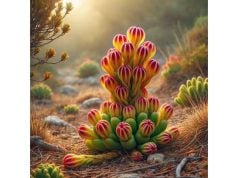Cajeput is a fascinating plant that has been part of various traditional wellness practices for centuries. Often recognized for its distinctive, penetrating aroma, it comes from the Melaleuca genus, which also includes tea tree and niaouli. The name “cajeput” is sometimes spelled as “cajuput,” and you’ll frequently see references to cajeput essential oil, an extract said to offer a wide range of benefits. Many people find cajeput appealing because its unique scent sets it apart from other botanical oils, making it a popular choice in aromatherapy blends and personal care products.
Cajeput trees typically grow in Southeast Asia, particularly in regions like Malaysia, Indonesia, Vietnam, and parts of Australia. These trees prefer swampy habitats or areas that experience seasonal flooding, and they are well known for their papery bark and slender, pointed leaves. The leaves contain potent bioactive compounds, including cineole (often listed as eucalyptol), which contributes to the plant’s characteristic aroma and potential benefits.
One reason cajeput has stood the test of time is its versatility. It has been used in everything from folk remedies and religious ceremonies to modern cosmetics and commercial wellness products. Some people apply cajeput oil topically for its warming sensation, while others diffuse it to freshen the atmosphere or add it to household cleaning solutions for a natural scent. Cajeput’s presence in ointments and liniments for sore muscles also highlights its broad appeal.
While cajeput is sometimes overshadowed by more famous relatives like eucalyptus and tea tree, it holds its own unique position in herbal lore and scientific research. As you delve deeper into its story, you’ll find that cajeput not only has a distinctive aroma but also a longstanding reputation for benefits that span respiratory support, skin care, and overall wellness. There’s a lot to discover about this remarkable herb—its life cycle, its centuries of use across different cultures, and the modern insights shaping how we incorporate it into daily routines.
- Often used to promote easier breathing and provide a fresh, invigorating aroma
- May help support comfortable joints and muscles when used in topical applications
- Known for its natural cleansing properties, both in personal care and household products
- Frequently included in skincare formulas for its balancing effects on oily or congested areas
- Shows promise in some wellness routines related to its unique blend of active compounds
Table of Contents
- Cajeput: A Comprehensive Botanical Overview and Identification
- Cajeput: Cultural Background and Historical Significance
- Cajeput: Primary Phytochemicals and Active Elements
- Cajeput: Broad Health Benefits and Well-Being Perspectives
- Cajeput: Notable Properties and Key Characteristics
- Cajeput: Practical Uses, Safety Tips, and Considerations
- Cajeput: Significant Research and Pertinent Findings
- FAQ
Cajeput: A Comprehensive Botanical Overview and Identification
Cajeput is part of the broad and diverse Myrtaceae family, which includes other well-known plants like clove, eucalyptus, and guava. The term “cajeput” most commonly refers to the Melaleuca cajuputi species, though closely related species in the same genus also carry similar names. In many regions, cajeput trees are recognized by their light, flaky bark—which sometimes peels off in thin layers—and narrow, pointed leaves that can range in color from greenish-gray to bright green, depending on environmental conditions.
Natural Habitat and Global Distribution
You’ll often find cajeput trees in wet, marshy environments or alongside riverbanks and coastal areas. The tree’s natural resilience allows it to tolerate waterlogged soil and sometimes even brackish water, which sets it apart from many other herbaceous or woody species that struggle in such conditions. Because of this adaptability, cajeput has spread across a wide swath of Southeast Asia and parts of Northern Australia.
Climate-wise, cajeput thrives in tropical and subtropical zones with consistent rainfall, warm temperatures, and plenty of sunshine. It’s not unusual to see large stands of cajeput trees in low-lying areas that flood during monsoon season. Their adaptability also means they can grow as a pioneering species in disturbed lands, helping to stabilize soil and support local ecosystems.
Physical Description
Cajeput’s trunk often appears to be twisted or leaning, especially if it’s grown in waterlogged soil. The bark itself is paper-like—pale white, off-white, or even slightly gray—hence the nickname “paperbark tree” that’s sometimes used for close relatives in the Melaleuca genus.
The tree’s leaves are typically long and narrow, with a pointed tip. If you crush a leaf between your fingers, you’ll immediately notice the strong, camphor-like scent, a clear indicator of the plant’s rich essential oil content. Cajeput also produces small, bottlebrush-like flowers that can be white, cream, or even pale green. These blossoms can appear in clusters along the stems, attracting pollinators like bees and other insects.
Subspecies and Varieties
Within the broader umbrella of Melaleuca cajuputi, you might find several subspecies that exhibit slight differences in leaf shape, bark texture, or flower coloration. Some cultivated varieties have been developed for ornamental use, prized for their unique bark and attractive flowers. However, when it comes to cajeput oil production, most industry attention focuses on the main species, M. cajuputi.
Cajeput’s strong aroma comes largely from cineole (eucalyptol), terpineol, and other monoterpenes. These are housed in specialized oil glands in the leaves. Through steam distillation, these volatile compounds are separated out to create cajeput essential oil, often used in aromatherapy, wellness products, or topical applications.
Identifying Cajeput in the Wild
If you happen to be near a marsh or along a tidal river in Southeast Asia, identifying cajeput can be fairly straightforward. Look for:
- Peeling, paper-like bark that’s pale or whitish.
- Narrow, lanceolate leaves that release a strong, medicinal aroma when crushed.
- Clustered flowers that resemble bottlebrushes, usually in light colors.
- Growth in wet or waterlogged soils, often in large groups.
In addition, cajeput seeds are minuscule and are usually dispersed by wind or water, allowing the plant to colonize quickly. When the seeds land in fertile, moist ground, they can sprout in a relatively short period, adding to their potential for forming dense stands.
Cultivation and Harvesting
For those interested in cultivating cajeput outside its native range, it’s important to replicate the tree’s need for abundant moisture and sunlight. In some subtropical areas with ample rainfall, cajeput can be grown as an ornamental, although in certain regions it’s considered invasive due to its aggressive growth habits. Cultivators mainly harvest the leaves for essential oil extraction, a process that usually involves steam distillation. Harvesting is timed to ensure that the oil content and its active compounds are at their peak.
In established plantations or wild-harvest sites, local harvesters may prune branches or strip leaves several times a year, as the tree can regenerate foliage relatively quickly. The efficiency of this process varies by region, depending on climate conditions, market demand, and labor practices.
Understanding how cajeput grows and how to identify it not only helps in appreciating the tree’s unique qualities but also informs sustainable harvesting practices. Knowing the difference between cajeput and other Melaleuca species can be crucial for commercial growers looking to produce high-quality cajeput oil. Whether you’re spotting a stand of trees in the wild or browsing essential oil offerings, it’s helpful to have a bit of background on this distinctive plant.
Cajeput: Cultural Background and Historical Significance
Cajeput’s story stretches far back in the annals of herbal tradition. In many parts of Southeast Asia, it has served as a go-to resource for everyday issues, as well as spiritual or ceremonial practices. Although it may not always grab the same headlines as more famous oils like tea tree or eucalyptus, cajeput has a rich heritage that reflects its importance among the communities where it naturally grows.
Traditional Uses Across Regions
Indigenous groups in places like Indonesia, Malaysia, and the Philippines have long utilized cajeput leaves and oil for various domestic and medicinal purposes. In certain cultures, cajeput leaves were used to freshen living spaces or were placed in bedding for their crisp aroma. Others incorporated cajeput into compresses or liniments for soothing physical discomforts. Because of its cooling-warming dual sensation, cajeput preparations found their way into many daily rituals.
In some traditions, cajeput oil was combined with coconut oil or other carrier oils to create balms for the temples, forehead, or chest. This practice stemmed from the belief that cajeput’s pungent aroma could help invigorate the senses and relieve pressure or tightness. Some people even mention older family members using cajeput-infused ointments for colicky infants or to massage the abdomen gently.
Role in Folk Medicine
Depending on the region, cajeput might be associated with spiritual or protective properties. For instance, it could be part of purification rituals or used to drive away negative energy. Although these practices haven’t necessarily been verified through modern research, they reflect the deep reverence local communities held for cajeput. The oil was seen as a gift from nature, one that had to be used respectfully and mindfully.
Malay traditional medicine is one cultural context where cajeput appears frequently. Healers sometimes rely on cajeput’s pungent characteristics to clear the air or purify certain spaces. In parts of Indonesia, cajeput may feature in jamu, a collection of herbal tonics and remedies. Meanwhile, in neighboring regions like Vietnam, the oil might show up in inhalations or herbal rubs for discomfort related to chilly or humid weather.
Introduction to Wider Markets
With the expansion of global trade during colonial eras, cajeput found its way onto international markets, traveling alongside other sought-after items like spices, silk, and herbal extracts. European explorers, intrigued by the region’s flora, often documented cajeput among other “exotic” plants. Over time, cajeput oil became an item in apothecaries across Europe, where it was sometimes listed as “Oleum Cajeputi” and recommended for various external uses.
In the modern age, cajeput has made its appearance in Western aromatherapy circles, albeit with a more niche following compared to heavy-hitters like peppermint, lavender, or tea tree. Nonetheless, cajeput’s crisp, camphor-like profile has garnered a loyal user base who appreciate its distinctive scent and possible wellness benefits.
Economic Importance
Although overshadowed by oils like eucalyptus or tea tree, cajeput still holds an economic role in certain parts of Asia. Small-scale farmers or collectors might harvest leaves to sell to distilleries or cooperatives that produce essential oil. Local markets in Indonesia or Malaysia often feature cajeput products, from small vials of oil to herbal balms, attesting to the plant’s continued popularity. These products can be found in local medicine shops or as part of broader handicraft offerings.
Regional governments in Asia sometimes encourage the planting of cajeput for reforestation or agroforestry projects, thanks to the tree’s resilience in wet environments and its commercial viability for oil production. Alongside this, there’s a push in certain areas to brand cajeput-based items for export, tying local heritage to global demand for natural, plant-based solutions.
Cultural Shifts and Modern Adaptations
As times change, cajeput has adapted to contemporary lifestyles and demands. It’s now packaged in more user-friendly forms, like roll-on sticks, inhalers, or pre-blended essential oil mixtures. Some modern herbalists incorporate cajeput oil in synergy blends aimed at promoting clear breathing or offering a refreshing sensation. Skincare brands sometimes highlight cajeput’s potential purifying or clarifying benefits in face washes and toners, although it remains less ubiquitous than tea tree in that field.
There’s a dual narrative at play: preserving the long-standing cultural uses of cajeput while also integrating them into contemporary, evidence-based wellness frameworks. Younger generations in Southeast Asia might learn about cajeput’s heritage from older relatives or through cultural festivals, while also exploring scientific data on its active components. In essence, cajeput serves as an example of a botanical that bridges generations, connecting ancient wisdom with modern curiosity.
In many ways, cajeput’s historical path is still unfolding. As global interest in natural and holistic health continues to rise, new research and product innovations are emerging. Yet at its core, cajeput remains what it has always been: a cherished plant with a deeply rooted cultural background, offering its characteristic aroma and multifaceted potential to those who seek it out.
Cajeput: Primary Phytochemicals and Active Elements
Cajeput’s distinctive sharp, menthol-like fragrance is a direct product of its rich chemical makeup. Like many aromatic plants, it owes much of its potential benefits to volatile compounds stored in tiny glands within its leaves. By understanding these compounds, we gain insight into what makes cajeput stand out among other herbal oils.
Volatile Compounds
The most prominent and well-known component of cajeput oil is cineole (1,8-cineole), which you might also recognize in eucalyptus and other camphorous essential oils. Cineole lends cajeput a cooling, piercing scent that people often find clarifying or invigorating. This compound is frequently studied for its potential to support respiratory health, ease congested feelings, or serve as a natural cleaning agent.
Beyond cineole, cajeput contains several monoterpenes and sesquiterpenes, including:
- Terpinene: Known for its fresh, piney aroma and sometimes discussed for its antiseptic-like traits.
- Terpineol: A fragrance compound that contributes a mildly floral, sweet note, often harnessed in perfumery.
- Limonene: Common to citrus peels and some conifers, bringing hints of lemony freshness.
- Alpha-Pinene: Another terpenic molecule commonly found in pine trees, recognized for its crisp scent and potential clarifying effects.
Non-Volatile Constituents
Although essential oils get most of the attention, cajeput’s leaves and bark also contain non-volatile compounds like flavonoids, tannins, and other polyphenols. While these may not contribute as strongly to the scent, they can influence the overall properties of cajeput when used in tinctures, teas, or other whole-plant applications. Polyphenols can sometimes act as antioxidants, neutralizing free radicals in certain contexts, although the specific polyphenol profile can vary depending on growing conditions and seasonal factors.
Extraction and Chemical Variation
It’s helpful to note that the chemical composition of cajeput oil can differ significantly based on factors like climate, soil type, altitude, and time of harvest. Some distillers may harvest leaves from younger twigs, while others prefer older leaves with higher oil concentrations. The distillation process itself—whether it’s done quickly or slowly, under high or low pressure—also affects which compounds end up in the final oil.
For commercial or therapeutic-grade cajeput oil, a high cineole content is often considered desirable. Many suppliers provide a breakdown of their oil’s composition, noting cineole as a percentage (e.g., 50% or higher). However, smaller-scale producers might sell cajeput oil with a distinct aroma profile influenced by local environmental nuances, yielding unique artisanal varieties.
Synergistic Effects
In aromatherapy and herbal medicine, there’s a concept called the “entourage effect” or “synergy,” where the various compounds in a plant interact in ways that may enhance or modify each other’s effects. Although cineole usually dominates cajeput’s profile, the supporting monoterpenes, sesquiterpenes, and minor compounds can tweak its aroma and potentially amplify specific benefits. For instance, alpha-pinene might help temper the more extreme pungency of cineole, creating a slightly softer or more balanced fragrance.
Comparing Cajeput to Related Oils
It’s easy to mix up cajeput with oils like eucalyptus, tea tree, or niaouli, since they all belong to the same botanical family (Myrtaceae) and share some aromatic similarities. However, subtle differences in the terpene ratios set them apart:
- Eucalyptus (Eucalyptus globulus): Often has an even higher cineole content, giving it a sharper, more linear scent.
- Tea Tree (Melaleuca alternifolia): Rich in terpinen-4-ol, leaning more medicinal and earthy rather than strictly camphorous.
- Niaouli (Melaleuca quinquenervia): Falls somewhere between tea tree and cajeput in terms of aroma, sometimes described as softer than cajeput but stronger than tea tree.
These distinctions might matter for those who create aromatherapy blends or are sensitive to certain compounds. Someone who finds eucalyptus too overpowering might find cajeput more palatable, whereas another person who adores the pungency of camphor might prefer eucalyptus.
Quality Control and Purity
When shopping for cajeput products, it’s a good idea to look for reputable sources that offer transparency about their extraction methods and the botanical identity of the plants. Adulteration can happen, where cajeput oil is diluted with cheaper oils or synthetic fragrances. Genuine cajeput oil should list “Melaleuca cajuputi” or a closely related species as the source, and ideally provide a chemotype or GC/MS (Gas Chromatography–Mass Spectrometry) analysis to confirm its composition.
Research Outlook
Scientists continue to investigate the roles of cajeput’s active constituents. Some studies examine how cineole might contribute to respiratory health, while others explore the oil’s antimicrobial or antioxidant activities. We’ll dig deeper into these studies in a later section, but for now, it’s enough to note that cajeput’s chemical complexity underlies many of its purported applications in traditional and modern wellness circles.
Overall, cajeput’s phytochemistry is a treasure trove of terpenes and other natural compounds, each offering a piece of the larger puzzle of how this plant interacts with our senses and bodies. The synergy of these components—especially cineole—brings cajeput its signature aroma and a range of potential uses that have intrigued many generations.
Cajeput: Broad Health Benefits and Well-Being Perspectives
Cajeput has long been cherished for more than just its crisp, penetrating aroma. Many people turn to cajeput—or products containing its essential oil—to help support a range of wellness goals. While personal experiences and cultural traditions often guide these uses, some of the benefits also receive interest from the scientific community. Below are some of the common ways cajeput features in discussions about overall health and daily comfort.
Respiratory Comfort and Freshness
One of the most popular reasons folks reach for cajeput is to promote a sense of clear breathing. By diffusing a few drops of cajeput oil or using a chest rub that includes it, some individuals feel it helps open up their airways. The strong, minty-camphorous scent associated with cajeput comes mainly from cineole. Cineole is frequently examined for its potential to soothe mild congestion and provide an invigorating lift when inhaled.
A variety of cultural practices involve cajeput for respiratory support. In Southeast Asia, for instance, it’s not uncommon to place a warm compress imbued with cajeput around the chest or neck. Some also blend cajeput with other essential oils, like peppermint or rosemary, to create a multi-layered aromatic experience. The synergy of these oils can enhance the refreshing feeling, though it’s always wise to ensure proper dilution and safety measures.
Comfort for Sore Muscles and Joints
Cajeput’s warming and sometimes cooling sensations can make it a valuable companion for muscle and joint care. After a long day or a strenuous workout, a massage oil containing cajeput may help bring about a sense of relief. The immediate warmth or tingling effect might relax tension, making it a popular addition to sports liniments or post-exercise balms.
People who enjoy creating homemade massage blends often combine cajeput with carrier oils such as coconut, sweet almond, or jojoba. This reduces the risk of skin irritation while still delivering the aromatic and potentially soothing qualities of cajeput. When used carefully, cajeput can supplement a broader approach to musculoskeletal comfort.
Skin-Cleansing and Clarifying Potential
In certain parts of the world, cajeput is utilized in skincare, particularly for those grappling with oily or blemish-prone complexions. Some credit cajeput’s natural cleansing properties with helping to balance the skin’s appearance. Occasional breakouts or areas of congestion could benefit from a targeted application of cajeput-infused toner or spot treatment.
It’s essential, however, to practice caution and proper dilution, since cajeput’s potency can irritate sensitive or broken skin. Often, it’s recommended to do a patch test before trying new topical formulations. Blending cajeput with gentler oils like lavender or chamomile also moderates the intense aroma and potential dryness that can result from frequent use.
Mindful Aromatherapy
The crisp, energizing scent of cajeput has found a niche in the field of aromatherapy. Some people diffuse cajeput oil when they need to sharpen their focus or lift their mood. The strong, sharp top note can be balanced with woody, floral, or citrus aromas to create a more layered experience. If you’re looking for a morning pick-me-up, diffusing cajeput or breathing it from a personal inhaler might serve as a natural alternative to other stimulants.
Cajeput is also favored by those who seek a purifying effect for their living spaces. Adding a few drops to a diffuser or a homemade cleaning solution can impart a feeling of freshness that’s reminiscent of open air. A noticeable difference between cajeput and other “refreshing” oils is cajeput’s subtle hint of sweetness beneath its potent camphor note.
Emotional and Energetic Outlook
Although more subjective, cajeput’s potential to influence mood and mental clarity should not be overlooked. Some find that cajeput helps clear mental fog and fosters a sense of alertness. In holistic wellness traditions, sharp, aromatic plants often symbolize energy and movement—an invitation to release stagnant thoughts or emotions.
Those who appreciate herbal traditions sometimes see cajeput as an ally for letting go of mental congestion. They might incorporate it into a daily ritual, like lighting a cajeput-scented candle or gently inhaling from a tissue with a drop or two of the oil before starting a meditation or journaling session. These practices remain largely anecdotal, but they highlight the deep cultural and personal significance cajeput carries.
Enhancing Massage and Self-Care Practices
Beyond targeted pain relief or respiratory applications, cajeput can also elevate self-care routines. A simple foot bath with a few drops of cajeput oil can feel surprisingly rejuvenating, as the warmth of the water and the aromatic vapor combine to soothe tired feet. If you enjoy steam inhalations, adding cajeput to a bowl of steaming water can create a sauna-like environment that both your skin and sinuses may appreciate.
Cajeput’s lively scent and warming-cooling features pair well with salt scrubs, bath bombs, or scalp treatments, providing a spa-like twist. Of course, it’s always wise to confirm that any product you’re using is properly formulated to be skin-friendly. While cajeput’s essential oil can be beneficial, direct undiluted contact with sensitive skin areas is generally not recommended.
Balanced Perspective
While many of these uses are informed by traditional practices and personal experiences, they should be approached with measured expectation. Cajeput might serve as a helpful companion for minor discomforts or as part of a broader wellness strategy, but it’s not a substitute for professional medical treatment. For example, if you’re dealing with chronic respiratory issues, you’ll want to consult a healthcare provider rather than relying on cajeput alone.
In short, cajeput’s broad-reaching appeal comes from the synergy of its aroma, thermogenic qualities, and potential cleansing actions. Whether you’re seeking a refreshing scent in your home or looking to incorporate an extra layer of warmth in a post-exercise massage, cajeput offers an interesting option. And for those who appreciate a bit of herbal tradition mixed with modern convenience, it may well earn a spot in the apothecary cabinet.
Cajeput: Notable Properties and Key Characteristics
Cajeput’s influence in both traditional and modern wellness circles rests on a variety of defining attributes. When people talk about “cajeput properties,” they’re usually referring to the particular traits—both physical and chemical—that give it such a strong personality. Understanding these properties can help you appreciate why cajeput might be included in everything from homemade balms to professional aromatherapy formulations.
Distinctive Aroma
Perhaps the first thing you’ll notice about cajeput is its bold fragrance. Often described as camphorous, herbal, and slightly sweet, cajeput’s scent profile is somewhat similar to eucalyptus but with subtle nuances. This characteristic smell is mainly driven by cineole (also called eucalyptol) and other monoterpenes, which combine to create a sharply penetrating aroma that some find cooling, while others describe it as warming or stimulating.
Thermogenic Qualities
A hallmark of cajeput is its paradoxical thermogenic effect—it can feel warming when massaged into the skin but also produce a cooling sensation when inhaled or applied in small amounts. This dual action can be particularly enticing for people seeking relief from physical discomfort or those who love the energizing snap of a brisk scent. The unique interplay of cajeput’s volatile compounds on skin and in the air sets it apart from many other herbal oils.
Potential Cleansing Action
Cajeput has a history of use in both personal hygiene and household cleaning. Some home remedy enthusiasts use cajeput as a go-to ingredient in homemade disinfectant sprays or surface cleaners, believing it can help keep spaces free from undesirable microbes. The evidence for cajeput’s antimicrobial properties is still evolving, but preliminary studies suggest certain elements in its essential oil might hinder bacterial and fungal growth. If you’re using cajeput in cleaning products, it helps to combine it with other potent oils (like lemon or tea tree) and test in small areas to avoid damaging sensitive surfaces.
Compatibility with Other Aromas
Unlike some pungent herbal oils that can dominate a blend, cajeput can harmonize surprisingly well with a range of other fragrances if used in the right proportions. For example, pairing cajeput with lavender can add a fresh twist to the floral calmness, while mixing it with citrus oils like bergamot or sweet orange can highlight the crisp, bright qualities of both ingredients. Likewise, woodsy notes such as cedarwood or sandalwood can tame cajeput’s intense top notes, offering a more balanced olfactory experience.
Fast Absorption in Topical Formulations
Cajeput essential oil is typically a thin, colorless, or pale yellow fluid, which means it can be absorbed relatively quickly when used in topical products. This is one reason cajeput might appear in formulas designed for quick relief of minor skin or muscle irritations. However, as with any essential oil, dilution is critical to avoid skin irritation. A standard rule of thumb is to keep the cajeput concentration to around 1-2% in lotions, creams, or oils meant for widespread application.
Purity and Concentration
Because cajeput shares some chemical similarities with more common oils—like eucalyptus—there’s a risk of adulteration in less reputable markets. Genuine cajeput oil should list Melaleuca cajuputi or a related species from the Melaleuca genus on the label. Quality tests, such as gas chromatography–mass spectrometry (GC/MS), can confirm that the cineole content and other components match typical cajeput profiles. When properly distilled, cajeput can have a cineole content ranging from 40% to over 60%, depending on factors like harvest time and environment.
Shelf Life and Storage
Properly stored cajeput oil can remain stable for around one to two years. Over time, exposure to light, heat, or air can degrade its volatile components, leading to changes in aroma and efficacy. To preserve its properties, store cajeput in a cool, dark place, ideally in an amber or cobalt glass bottle with a well-sealed cap. Keeping it away from moisture or wide temperature fluctuations also helps extend its useful life.
Environmental Impact
Cajeput trees grow in swampy areas and can help stabilize wetlands or rehabilitate damaged landscapes. This capacity makes them an ecologically significant species in certain regions. However, in places where they are not native, cajeput can sometimes become invasive, outcompeting local flora. Sustainable harvesting practices, along with responsible cultivation, play a crucial role in maintaining balanced ecosystems while allowing communities to benefit from cajeput’s commercial potential.
In sum, cajeput’s properties include a dynamic aroma profile, a unique warming-cooling effect, potential cleansing actions, and relative ease of blending with other essential oils. Its chemical complexity makes it a fascinating subject for ongoing research and a versatile component in personal care, home cleaning, and aromatherapy. Yet, it also demands respect, both in terms of mindful usage (to prevent skin reactions) and sustainable sourcing (to protect native habitats). All these features combine to make cajeput a botanical gem in the broader world of herbal therapies.
Cajeput: Practical Uses, Safety Tips, and Considerations
From time-honored applications in folk medicine to modern-day wellness routines, cajeput has a broad array of uses. Yet, as with any potent plant extract, there are guidelines and precautions to keep in mind. Below, we’ll explore some of the common ways to incorporate cajeput into daily life while maintaining a balanced perspective on safety.
Topical Applications and Massage
Many people apply cajeput oil to the skin in diluted form, capitalizing on its potential to soothe tired muscles or refresh the senses. If you’re looking to make a DIY massage blend, start by adding about 1-2 drops of cajeput oil per teaspoon of carrier oil (such as fractionated coconut, almond, or jojoba oil). This ratio typically ensures the oil remains gentle enough for most skin types while still delivering its characteristic warmth.
- Post-Workout Routine: A small, diluted dose can go a long way in offering a pleasant, warming-cooling sensation to overworked areas.
- Tension Relief: Some folks like to apply a cajeput-infused balm around their temples or neck, especially if they’re feeling physically tense. Just remember to keep it away from your eyes and any sensitive mucous membranes.
Aromatic Uses and Diffusion
Cajeput’s sharp and invigorating fragrance makes it a popular choice in aromatherapy. Using a diffuser can help you enjoy the scent without over-saturating the air. Adding 4-6 drops of cajeput oil to your diffuser (depending on room size) can produce a noticeable freshness. You can also blend it with other oils for a more rounded aroma, such as lavender for a calming touch or lemon for an extra citrusy spark.
- Boosting Concentration: Some prefer diffusing cajeput in a home office or study area to encourage a sense of alertness.
- Indoor Air Freshening: When you want to neutralize stale or musty odors, cajeput offers a bright yet herbal edge that can liven up a space.
Inhalation and Steam Baths
For individuals looking to support clear breathing, inhaling cajeput through steam can be particularly soothing. Simply add 1-2 drops of cajeput oil to a bowl of hot water, then lean over it with a towel draped around your head, creating a tent. Inhale the aromatic steam for a few minutes, taking slow, steady breaths. This process might help open up stuffy feelings in the nose or chest. Exercise caution, though, and keep your eyes closed or protected since cajeput’s fumes can be strong.
Household Cleaning Solutions
If you enjoy natural cleaning methods, you can integrate cajeput into homemade sprays or all-purpose cleaners. A few drops combined with vinegar, water, or soap-based formulas can impart a fresh scent while offering a certain level of cleansing power. Just be sure to do a spot test on delicate surfaces to ensure no damage occurs.
- Floor Cleaners: A cajeput-infused solution can be refreshing when mopping floors, but watch for slipperiness if you use oil in higher quantities.
- Air Mists: Diluting a small amount of cajeput oil in distilled water with a bit of solubilizer (like grain alcohol or polysorbate) makes for a handy room spray.
Important Safety Precautions
While cajeput has a lot to offer, it’s vital to handle it with care:
- Dilution: Always dilute cajeput essential oil in a carrier or base product (like lotions, creams, or shampoos) before applying to skin. Undiluted use may cause irritation or sensitization.
- Patch Test: If you’re new to cajeput or have sensitive skin, do a patch test on your forearm and wait 24 hours to see if any redness or itching occurs.
- Avoid Eye Contact: The potent aroma can irritate mucous membranes, including eyes and nasal passages. Keep cajeput away from your face unless it’s properly diluted.
- Caution During Pregnancy: Consult a healthcare professional if you’re pregnant, breastfeeding, or have underlying health conditions. Some essential oils may not be suitable during these stages.
- Safe Storage: Keep cajeput oil in a dark, sealed container away from children and pets. This helps preserve its chemical integrity and prevent accidental ingestion.
Special Populations and Sensitivities
Certain groups might want to exercise extra caution:
- Children: Because of cajeput’s strong cineole content, it may not be recommended for very young kids, particularly those under age 2, when used in direct inhalation or chest rubs. Always consult pediatric guidelines.
- Pets: Some essential oils can be harmful to pets, especially cats. If you plan to diffuse cajeput in a shared space with animals, ensure there’s proper ventilation and a way for them to leave if they’re uncomfortable.
Balanced Integration
Combining cajeput with other complementary oils or herbs can amplify or refine its beneficial effects. For instance, pairing cajeput with peppermint might enhance the cooling aspect, while blending it with a floral note like geranium can lighten the camphorous punch. Many herbalists and aromatherapists advocate for synergy in essential oil usage, suggesting that well-matched blends might outperform individual oils on their own.
In the grand scheme of natural wellness, cajeput’s role hinges on careful, informed usage. It can be a handy ally for supporting respiratory comfort, refreshing living spaces, and relieving minor muscle tension—provided you use it responsibly. By following standard precautions and incorporating it into your routines with mindfulness, you can enjoy its vivacious scent and supportive properties without overstepping safety boundaries.
Cajeput: Significant Research and Pertinent Findings
Although cajeput may not be as extensively studied as some other botanical oils, there’s an increasing body of research that examines its chemical composition and potential effects. Much of the modern interest in cajeput centers around its essential oil, with various scientific papers delving into aspects such as antimicrobial properties, anti-inflammatory possibilities, and the psychological impact of its scent.
Antimicrobial and Antifungal Activity
A growing number of laboratory studies have looked at cajeput oil to see how it might fare against bacteria, fungi, and other microbes. For instance, a 2018 study published in the Journal of Applied Microbiology explored cajeput’s efficacy in inhibiting the growth of certain bacterial strains commonly associated with skin or respiratory issues. The researchers found that cajeput’s high cineole content was a key factor, although results varied among different strains.
In another investigation, featured in the Mycological Research journal, cajeput extracts were tested against various fungal cultures, suggesting potential antifungal capabilities. While these findings hint that cajeput could have a role in natural disinfectants or topical formulations, most studies emphasize that more in-depth clinical trials are needed to translate lab observations into real-world efficacy.
Respiratory and Anti-Inflammatory Studies
Given cajeput’s longstanding use for respiratory support, it’s no surprise that researchers have examined how it interacts with mucus membranes and airways. One 2021 paper in the International Journal of COPD looked at how inhaling cineole-rich oils might improve airflow in individuals with mild respiratory discomfort. The study noted a modest but noteworthy improvement in perceived breathing ease, attributing it partly to the aromatic stimulation and potential anti-inflammatory activity.
Other research, including a 2019 review in Phytotherapy Insights, examined how cajeput’s monoterpenes might modulate inflammatory markers in cell cultures. Some data suggested that these compounds could help reduce the production of pro-inflammatory cytokines. However, it’s important to note that these outcomes are still preliminary and require additional validation in human trials.
Topical Applications and Skin Support
In the realm of skincare, cajeput is sometimes discussed for its purifying qualities. A 2020 study in the Dermatological Science & Research journal tested formulations containing small percentages of cajeput oil on volunteers with oily-prone skin. The results indicated a slight improvement in skin clarity for a portion of participants, although the researchers noted that cajeput should always be carefully diluted to prevent irritation.
Another angle involves synergy. A 2022 article in the Journal of Essential Oil Research found that combining cajeput with other essential oils (like lavender or geranium) could produce more balanced results, particularly for individuals with mixed or sensitive skin types. The team proposed that cajeput’s robust components might be tempered by more gentle oils, thus widening its application in over-the-counter skincare products.
Psychological Effects of Aromatherapy
Cajeput’s crisp and uplifting scent has led some researchers to explore its impact on mood or mental clarity. A small-scale 2021 pilot study in Aromatherapy & Well-Being used cajeput-scented inhalers in a group of office workers who reported afternoon slumps in alertness. The study found a modest uptick in self-reported concentration and energy levels compared to a control group using unscented inhalers. While these results are intriguing, the sample size was limited, and further research would be essential for stronger conclusions.
FAQ
What is cajeput oil used for?
Cajeput oil is often used to promote easier breathing, soothe tired muscles, and freshen indoor spaces with its invigorating aroma. Many people include it in massage blends, diffusers, or homemade cleaning solutions. Its warm-cooling feel and bold scent come primarily from cineole, a major active component.
Is cajeput the same as tea tree oil?
They’re closely related but not identical. Both come from the Melaleuca genus, yet they contain different chemical profiles. Cajeput has a sharper, more camphor-like aroma, while tea tree oil (Melaleuca alternifolia) tends to smell more medicinal and earthy. Each offers unique benefits and properties.
How should cajeput oil be diluted for topical use?
A common guideline is to start with about 1-2 drops of cajeput per teaspoon of a carrier oil, such as coconut or jojoba oil. This helps minimize the risk of skin irritation. Always do a patch test before wider application, especially if you have sensitive skin.
Can I diffuse cajeput oil around pets?
Cajeput’s strong aroma might be overwhelming for some animals. If you diffuse it, make sure the area is well-ventilated, and your pets have a way to leave if they’re uncomfortable. Consult a veterinarian for advice on using any essential oil near cats, dogs, or other animals.
Is cajeput safe during pregnancy?
Opinions vary, but many experts recommend caution. Due to its strong components like cineole, pregnant or nursing individuals should talk to a healthcare provider before using cajeput or any potent essential oil. It’s best to err on the side of caution.
Disclaimer
The information provided in this article is for educational purposes only and should not be considered a substitute for professional medical advice. Always consult a qualified healthcare practitioner for concerns about your health or before using new products.
If you found this article helpful, feel free to share it on Facebook, X (formerly Twitter), or wherever you enjoy connecting online. Spreading the word helps others learn about cajeput and its many possibilities!











